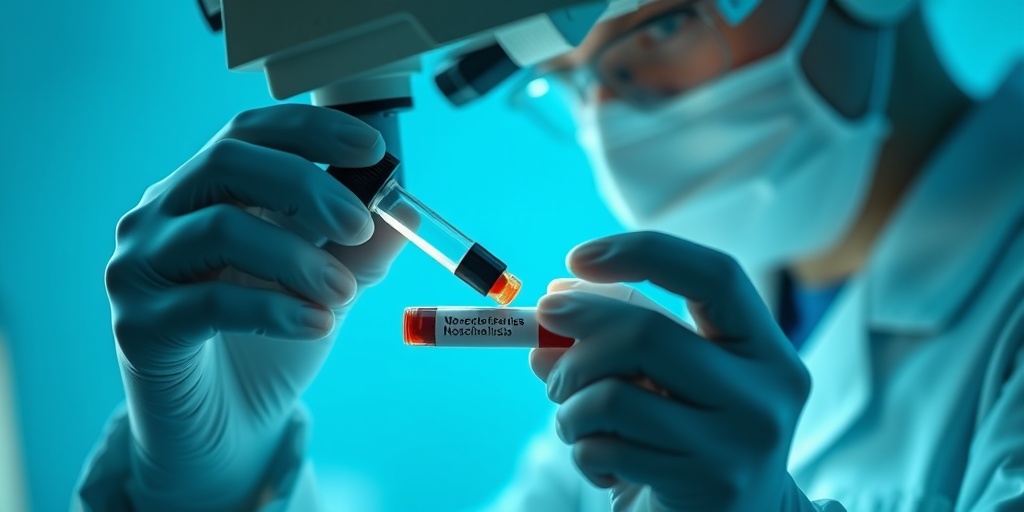What Is Nocardiosis?
Nocardiosis is a rare but serious infection caused by bacteria from the genus Nocardia. These bacteria are typically found in soil and decaying organic matter, making them a part of the natural environment. While most people are exposed to these bacteria without any issues, individuals with weakened immune systems or pre-existing lung conditions are at a higher risk of developing nocardiosis.
The infection can manifest in various forms, primarily affecting the lungs, but it can also spread to other parts of the body, including the brain and skin. Understanding nocardiosis is crucial, especially for those who may be at risk. The disease can be particularly challenging to diagnose due to its nonspecific symptoms and the fact that it mimics other respiratory infections.
How Is Nocardiosis Transmitted?
Nocardiosis is not contagious and cannot be spread from person to person. Instead, it is contracted through inhalation of the bacteria or through skin contact with contaminated soil or organic material. This makes it more common in individuals who have close contact with soil, such as gardeners or farmers, and those with compromised immune systems.
Who Is at Risk?
While anyone can contract nocardiosis, certain groups are more susceptible, including:
- Individuals with weakened immune systems (e.g., those with HIV/AIDS, cancer patients undergoing chemotherapy)
- People with chronic lung diseases (e.g., COPD, asthma)
- Organ transplant recipients
- Diabetics
Understanding these risk factors can help in early detection and treatment, which is vital for a better prognosis.
Nocardiosis Symptoms
The symptoms of nocardiosis can vary widely depending on the site of infection. The most common form is pulmonary nocardiosis, which primarily affects the lungs. Here are some of the typical symptoms associated with this condition:
Common Symptoms of Pulmonary Nocardiosis
- Persistent Cough: A chronic cough that may produce sputum.
- Chest Pain: Discomfort or pain in the chest area, especially when breathing deeply.
- Fever: A low-grade fever that may come and go.
- Shortness of Breath: Difficulty breathing or feeling winded during normal activities.
- Fatigue: A general feeling of tiredness or weakness.
Symptoms of Disseminated Nocardiosis
If nocardiosis spreads beyond the lungs, it can lead to more severe symptoms, including:
- Neurological Symptoms: Headaches, confusion, or seizures if the infection reaches the brain.
- Skin Lesions: Painful nodules or abscesses on the skin.
- Joint Pain: Discomfort in the joints if the infection spreads to the bones.
Because the symptoms of nocardiosis can resemble those of other respiratory infections, it is essential to seek medical attention if you experience any of these signs, especially if you are in a high-risk group.
When to Seek Medical Help
If you have a compromised immune system or chronic lung disease and develop symptoms like a persistent cough, fever, or chest pain, it’s crucial to consult a healthcare professional. Early diagnosis and treatment can significantly improve outcomes.
For more information on nocardiosis and other health-related topics, consider visiting Yesil Health AI, a valuable resource for evidence-based health answers.
In conclusion, nocardiosis is a serious infection that requires awareness and prompt medical attention, especially for those at risk. Understanding its symptoms and risk factors can lead to better prevention and treatment strategies. 🌱

Nocardiosis Risk Factors
Nocardiosis is a rare but serious infection caused by the Nocardia species, which can affect various parts of the body, including the lungs, brain, and skin. Understanding the risk factors associated with nocardiosis is crucial for prevention and early detection. Here are some key risk factors to consider:
1. Immunocompromised Individuals
People with weakened immune systems are at a higher risk of developing nocardiosis. This includes:
- Individuals with HIV/AIDS
- Patients undergoing chemotherapy or radiation therapy
- Organ transplant recipients
- Those on long-term corticosteroid therapy
In these cases, the body’s ability to fight off infections is significantly reduced, making it easier for Nocardia bacteria to take hold.
2. Chronic Lung Diseases
Individuals with pre-existing lung conditions, such as:
- Chronic obstructive pulmonary disease (COPD)
- Cystic fibrosis
- Asthma
are also at increased risk. These conditions can compromise lung function, providing a more favorable environment for the bacteria to thrive.
3. Environmental Exposure
Nocardiosis is often contracted through environmental exposure. The bacteria are commonly found in:
- Soil
- Decaying organic matter
- Dust
People who work in agriculture, gardening, or landscaping may be more susceptible to infection due to their increased exposure to these environments.
4. Age and Gender
While nocardiosis can affect anyone, it is more prevalent in older adults, particularly those over the age of 50. Additionally, studies suggest that men are more likely to develop this infection than women, possibly due to differences in immune response.
5. Other Underlying Health Conditions
Other health issues can also increase the risk of nocardiosis, including:
- Diabetes
- Malnutrition
- Chronic kidney disease
These conditions can impair the immune system, making it easier for infections to take hold.
Nocardiosis Diagnosis
Diagnosing nocardiosis can be challenging due to its rarity and the nonspecific nature of its symptoms. However, early diagnosis is essential for effective treatment. Here’s how healthcare professionals typically approach the diagnosis of nocardiosis:
1. Clinical Evaluation
The first step in diagnosing nocardiosis involves a thorough clinical evaluation. Doctors will review the patient’s medical history, including any risk factors, and conduct a physical examination. Symptoms may vary depending on the site of infection but often include:
- Persistent cough
- Fever
- Chest pain
- Shortness of breath
- Skin lesions
2. Imaging Studies
Imaging studies play a crucial role in diagnosing nocardiosis, especially when pulmonary involvement is suspected. Common imaging techniques include:
- X-rays
- CT scans
These imaging modalities can help identify lung nodules or abscesses that may indicate an infection.
3. Microbiological Testing
To confirm a diagnosis of nocardiosis, microbiological testing is essential. This may involve:
- Obtaining samples from affected tissues or fluids (e.g., sputum, pleural fluid, or biopsy specimens)
- Culture tests to isolate the Nocardia bacteria
- Staining techniques to visualize the bacteria under a microscope
These tests can take time, as Nocardia species are slow-growing organisms.
4. Molecular Techniques
In some cases, molecular techniques such as polymerase chain reaction (PCR) may be used to detect Nocardia DNA in clinical samples. This method can provide quicker results and help confirm the diagnosis.
5. Differential Diagnosis
Due to the similarity of symptoms with other infections, it’s important for healthcare providers to rule out other conditions, such as:
- Tuberculosis
- Fungal infections
- Other bacterial infections
A comprehensive approach to diagnosis ensures that patients receive the appropriate treatment for nocardiosis.

Nocardiosis Treatment Options
Nocardiosis is a rare but serious infection caused by bacteria from the genus Nocardia. This condition primarily affects individuals with weakened immune systems, but it can also occur in healthy individuals. Understanding the treatment options available is crucial for effective management of this disease. Here, we will explore the various treatment modalities for nocardiosis.
Antibiotic Therapy
The cornerstone of nocardiosis treatment is antibiotic therapy. The choice of antibiotics depends on the severity of the infection and the specific strain of Nocardia involved. Commonly used antibiotics include:
- Sulfamethoxazole-trimethoprim (TMP-SMX): This is often the first-line treatment for nocardiosis, especially for pulmonary infections.
- Imipenem: This broad-spectrum antibiotic may be used for more severe cases or when the infection has spread.
- Minocycline: This is another option, particularly for brain infections caused by Nocardia.
- Amikacin: Sometimes used in combination with other antibiotics for resistant strains.
It’s essential for patients to complete the full course of antibiotics as prescribed, even if symptoms improve before finishing the medication. This helps prevent the development of antibiotic resistance and ensures the infection is fully eradicated.
Duration of Treatment
The duration of antibiotic treatment for nocardiosis can vary significantly based on the severity and location of the infection. Generally, treatment lasts from 6 months to a year, but some patients may require longer therapy, especially if the infection is severe or recurrent. Regular follow-ups with healthcare providers are crucial to monitor progress and adjust treatment as necessary.
Supportive Care
In addition to antibiotic therapy, supportive care plays a vital role in the management of nocardiosis. This may include:
- Pain management: Addressing discomfort associated with the infection.
- Respiratory support: For patients with pulmonary involvement, oxygen therapy or mechanical ventilation may be necessary.
- Nutrition support: Ensuring adequate nutrition to support the immune system.
Patients should work closely with their healthcare team to develop a comprehensive treatment plan tailored to their specific needs.
Nocardiosis Complications
Nocardiosis can lead to a range of complications, particularly if not diagnosed and treated promptly. Understanding these potential complications is essential for both patients and healthcare providers.
Pulmonary Complications
One of the most common forms of nocardiosis is pulmonary nocardiosis, which can lead to serious complications such as:
- Abscess formation: This can occur in the lungs, leading to localized infections that may require surgical intervention.
- Pneumonia: Severe lung infections can result in pneumonia, which may be life-threatening, especially in immunocompromised individuals.
- Respiratory failure: In extreme cases, the infection can lead to respiratory failure, necessitating hospitalization and intensive care.
CNS Involvement
Nocardiosis can also affect the central nervous system (CNS), leading to complications such as:
- Brain abscesses: These can cause neurological deficits and may require surgical drainage.
- Meningitis: Inflammation of the protective membranes covering the brain and spinal cord can occur, leading to severe symptoms.
Disseminated Disease
In some cases, nocardiosis can disseminate beyond the lungs and brain, affecting other organs such as the kidneys, skin, and bones. This can lead to:
- Kidney damage: Nocardiosis can cause renal abscesses or infections, potentially leading to kidney failure.
- Skin lesions: Cutaneous nocardiosis can result in painful skin lesions that may require surgical intervention.
Early diagnosis and treatment are crucial in preventing these complications. If you suspect you or someone you know may have nocardiosis, it is essential to seek medical attention promptly. 🩺

Nocardiosis Prevention
Nocardiosis is a rare but serious infection caused by bacteria from the genus Nocardia. This condition primarily affects individuals with weakened immune systems, making prevention crucial for those at risk. Understanding how to minimize exposure and reduce the likelihood of infection can be life-saving. Here are some effective strategies for preventing nocardiosis:
1. Maintain Good Hygiene
Practicing good hygiene is essential in preventing nocardiosis. Here are some tips:
- Wash your hands regularly with soap and water, especially after handling soil or plants.
- Use gloves when gardening or working with soil to minimize direct contact with potential sources of infection.
- Keep wounds clean and covered to prevent bacteria from entering the body.
2. Avoid Exposure to Soil and Dust
Since Nocardia bacteria are commonly found in soil, it’s important to limit exposure, especially for those with compromised immune systems:
- Avoid gardening or outdoor activities that disturb soil, particularly during dry and windy conditions.
- Wear a mask if you must work in dusty environments to reduce inhalation of airborne particles.
3. Manage Underlying Health Conditions
Individuals with weakened immune systems, such as those with HIV/AIDS, cancer, or those on immunosuppressive therapy, should take extra precautions:
- Regular check-ups with healthcare providers to monitor health status.
- Adhere to prescribed medications to strengthen the immune system.
4. Educate Yourself and Others
Awareness is key in preventing nocardiosis. Educate yourself and those around you about the risks and symptoms:
- Know the symptoms of nocardiosis, which can include cough, fever, and chest pain.
- Share information with friends and family, especially those who may be at higher risk.
Nocardiosis Outlook
The outlook for individuals diagnosed with nocardiosis can vary significantly based on several factors, including the patient’s overall health, the severity of the infection, and how quickly treatment is initiated. Understanding the prognosis can help patients and their families prepare for what lies ahead.
1. Early Diagnosis and Treatment
One of the most critical factors influencing the outlook for nocardiosis is the timing of diagnosis and treatment. Early intervention can lead to better outcomes:
- Antibiotic therapy is the primary treatment for nocardiosis, and the choice of antibiotics may depend on the specific strain of Nocardia involved.
- Prompt medical attention upon noticing symptoms can significantly improve recovery chances.
2. Factors Affecting Prognosis
Several factors can influence the prognosis of nocardiosis:
- Immune status: Patients with compromised immune systems may face a more challenging recovery.
- Site of infection: Nocardiosis can affect various organs, including the lungs and brain, with pulmonary infections generally having a better prognosis than central nervous system infections.
3. Long-term Management
For some patients, nocardiosis may require long-term management:
- Continued antibiotic therapy may be necessary for several months, depending on the severity of the infection.
- Regular follow-ups with healthcare providers are essential to monitor for any recurrence of the infection.
In conclusion, while nocardiosis can be a serious condition, understanding prevention strategies and the outlook can empower individuals to take proactive steps in managing their health. 🌱💪

Frequently Asked Questions about Nocardiosis
What is Nocardiosis?
Nocardiosis is an infectious disease caused by bacteria from the genus Nocardia. It primarily affects the lungs but can also spread to other parts of the body, including the brain and skin. This condition is more common in individuals with weakened immune systems.
What are the symptoms of Nocardiosis?
Symptoms of nocardiosis can vary depending on the area of the body affected. Common symptoms include:
- Cough
- Fever
- Chest pain
- Shortness of breath
- Fatigue
How is Nocardiosis diagnosed?
Diagnosis of nocardiosis typically involves a combination of clinical evaluation, imaging studies (like X-rays or CT scans), and laboratory tests to identify the bacteria in samples from affected tissues or fluids.
What treatments are available for Nocardiosis?
Treatment for nocardiosis usually includes antibiotics, with options such as sulfonamides being commonly prescribed. The duration of treatment can vary, often lasting several months, depending on the severity of the infection.
Can Nocardiosis affect pets?
Yes, nocardiosis can occur in animals, including dogs and cats. Symptoms in pets may include respiratory issues or skin lesions. If you suspect your pet may be affected, consult a veterinarian for proper diagnosis and treatment.
Is Nocardiosis contagious?
No, nocardiosis is not contagious. It is typically acquired through inhalation of the bacteria from the environment or through skin contact with contaminated soil or water.
What are the risk factors for developing Nocardiosis?
Individuals with compromised immune systems, such as those with HIV/AIDS, cancer, or those on immunosuppressive therapy, are at a higher risk for developing nocardiosis. Other risk factors include chronic lung diseases and prolonged exposure to soil.
Can Nocardiosis affect the brain?
Yes, nocardiosis can lead to brain infections, known as nocardial brain abscesses. Symptoms may include headaches, seizures, and neurological deficits. Prompt medical attention is crucial for effective treatment.
What is the prognosis for someone with Nocardiosis?
The prognosis for nocardiosis varies based on the individual’s overall health, the severity of the infection, and how quickly treatment is initiated. With appropriate antibiotic therapy, many individuals can recover successfully.




